How to make an alpine slide with stones with your own hands?
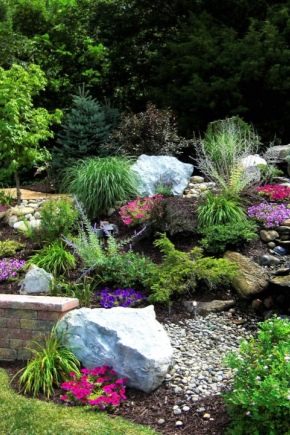
In the modern landscape design of a country house or summer cottage, you can often find rock gardens that have become very popular recently. The creation of the so-called alpine slide is not only a decoration of a land plot, but also a fascinating creative business. The process of building a flower garden is a rather laborious and responsible occupation, which must be approached with knowledge of the matter, taking into account many nuances. But the result is worth it - at the end of the work, you will be delighted with a unique inimitable composition of plants rooted on stones, the flowering of which does not stop from spring to late autumn.

What it is?
Alpine slide is one of the landscape design techniques, which is created on level ground or a small hill, imitating mountain slopes with the help of stones of various sizes, overgrown with dwarf shrubs and perennial flowering plants. Variations for creating an alpine flower garden are very diverse - in addition to plants, they can contain small ponds, bridges, garden sculptures inside the composition. Slides made in the form of tiers-terraces, as well as with the use of illumination in the evening and at night, look very unusual and beautiful.
Of course, the construction of such structures requires certain design developments. and the experience of bringing ideas to life. Much in the appearance of a flower garden will depend on the type of stones and their shape, which will be taken as a basis. The size of the stones also plays an important role.


Skillfully combining the texture of the stone and choosing the right plants is a difficult task, but quite doable, anyone who wants to delve into the intricacies of creating an artificial landscape can cope with it.
Views
When creating a landscape flower garden, you can independently use simple ready-made design schemes or resort to the help of specialists for the individual development of the project and perform all the necessary work.
You can equip garden landscapes using various types of rock gardens:
-
Hill of stones - this is the easiest option to manufacture, it requires a small hill in the form of an earthen embankment and stones of various sizes, which are located in an arbitrary order on this hill. The size of the slide can be any, and the simplicity and brevity of this design allows it to be appropriate anywhere on the site;



-
Flower garden using the existing landscape - a flat area or a natural natural slope is taken as the basis for building a composition. The scope for creativity here is unlimited - the territory being developed can be decorated with a waterfall, a pond can be organized, and artificial decorative elements can be placed. In execution, this type of rock garden is quite simple, since a base naturally created by nature is used, to which the necessary additions are added;

- Rock garden using architectural components - this type of landscape design must be developed in such a way that it is combined with the general architectural idea of the house located on the site. The structure of such an alpine slide contains clear and regular terraces, tiled borders, paths. It is rather difficult to create such a project.It is necessary to take into account many points, which consist not only in the selection of forms and materials, but also in the choice of the corresponding general concept of plants;


- Stepped terraces - to implement this option, an embankment with a steep slope is required, where low walls are fixed at various levels, which act as a support for holding the soil. The length, height and frequency of the location of such walls can be chosen any, depending on the design idea. The terrace itself can be small and narrow, or, conversely, wide and high. Plants are planted on the surface of the terrace, using large or mini-specimens in such a way that they do not shade each other and harmoniously complement the general appearance of the composition;


- Rock or hill - this type of construction involves the creation of a large elevation that imitates the miniature of a rock or cliff. Sometimes, for the construction of such a hill, plastic imitations of large stones are used or natural large-sized specimens are brought. The process of creating this kind of design is quite laborious, but this rock garden looks great in its finished form. Designers often use this type of rock garden in areas where the area itself has a hilly landscape;


- Rockery - a kind of rock garden, created on a flat surface of the site of stones and gravel. Against the background of the general landscape, the compositions with large stones mark the highest points, creating with them a kind of accent that attracts attention. For this purpose, rounded boulders or limestone can be used. Rockeries are often made with a small reservoir. The implementation of such an idea does not require a global investment of effort, time and money, therefore this type of rock garden is very common. Rockery can be large or miniature, made literally from improvised means taken as a basis - a large clay pot or ceramic flowerpot, an old boat, even unusable boots can be turned into a mini-garden pleasing to the eye;


-
Alpine lawn - this kind of landscape consists of a skillful combination of small alpine hills, flat rockeries and rocky hills. The most important condition is that the combination of these species should be so harmonious that the impression of naturalness is created. An alpine lawn requires a fairly large surface, so it is only suitable if the area of the land plot allows it. Another difficulty lies in the fact that the plants used for such a flower garden, over time, begin to compete with each other for space and the stronger crowd out the weak, while the balance of the decorative composition is lost. In addition, weeds also actively interfere with the artificially created landscape and disrupt the overall harmony even with good and regular maintenance. And after a few years, the entire lawn has to be radically redone;
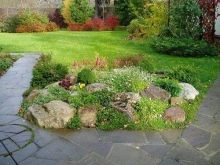


-
Gravel flower garden easy enough to create and looks impressive. Gravel and large stones are placed on the soil covered with a protective film; a garden sculpture or a fountain can become the center of the composition. A small number of plants are planted near large stones - most often they are perennials or evergreen dwarf conifers. The flower garden is decorated with lighting. If desired, the elements of the composition can be easily replaced or supplemented with other types.
A lot of ideas for creating flower beds can be gleaned from nature itself. To do this, you just need to carefully observe it in natural conditions, look at materials about mountain flora and lowland landscapes.


Any flower garden will delight the eye and will successfully fit into the overall architectural concept of the site only when it is as close as possible to the natural forms and proportions.
Seat selection
Before starting work on the creation of an alpine slide, it is necessary to determine its location. In this case, it is necessary to take into account the general plan of the garden or land plot, taking into account the existing trees and buildings. It is necessary to build a flower garden so that it is clearly visible from any point of the site and each side of it looks harmonious.
The most successful places for accommodation are considered to be:
-
not far from the entrance to the site;
-
near the entrance to the house;
-
on a site in a recreation area;



-
opposite the front of the house;
-
near the terrace or on the side of the house where there is a balcony.
In a garden with tall trees, it is best to choose a place for a rock garden in an area far from the trees, so that their shade does not interfere with the growth of small plants. If the land plot is located on a slope, the best place for a flower garden will be a place on its top, where there is a lot of light and fresh air. To break down an alpine slide, you can choose small shrubs as your best neighbor; against their background, the whole composition will look appropriate and realistic.
But near the iron fence, the flower garden will look like a loser, and even heating up in the sun, the metal will create not the best microclimate for plants.



Plants for rock garden usually choose perennial, ampelous or evergreen. Therefore, for them, the optimal conditions will be the place where there is partial shade and good air circulation. Constant sunshine, stagnant water in the ground and frequent strong winds can adversely affect many types of vegetation.
Preparatory work
After the place for the slide is determined, it is necessary to create a model of the future rock garden. It can be done in the form of sketches yourself or you can use a ready-made design project. According to the planned dimensions, the territory is marked on the site, indicating the contours of the structure, as well as the location of large significant elements. In this case, clear geometric shapes should be avoided, as irregular outlines will look more realistic.


The technology of building an alpine flower garden implies the creation of a kind of autonomous ecosystem, which must correspond not only to a decorative purpose, but also provide conditions for the growth and development of living plants placed in it. It is important for them that the soil has good drainage and that there is no stagnant water in it, which would lead to rotting of the root system.
Therefore, the first preparatory stage will be the creation of a flower garden drainage system.


To do this, you should adhere to the following work algorithm:
-
remove the top layer of soil by about 20-30 centimeters;
-
gravel, broken brick is laid out in the resulting pit, and then tamped well, while the total thickness of the layer should be 10-15 centimeters. If the project provides for the use of large-sized stones, it is advisable to install them after soil shrinkage, which occurs naturally after three weeks;
-
the second layer is laid coarse sand also at a height of 10-15 centimeters and well tamped it;






-
a mixture of peat and humus is laid in a third layer, forming a platform for a flower garden. After the next natural shrinkage of the soil, it is already possible to outline the contours of the hills and place the remaining stones. For smaller stones, it is imperative to make depressions, otherwise the effect of precipitation and wind will erode the soil under them, which will lead to the loss of their stability. Between the stones, you need to leave free space for placing plants.
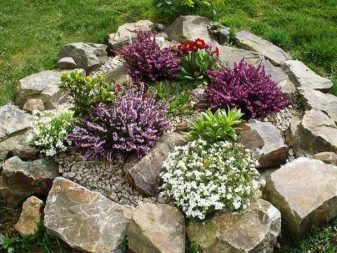
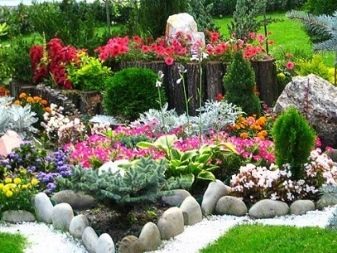
Most often, preparatory work is carried out in the autumn. This is done so that the soil can settle properly over the winter. By the spring, the prepared site will be completely ready for the rest of the work.



Choosing stones
The choice of stones directly depends on the design concept of the flower garden project.In the natural environment, stones have chips and uneven surfaces, which creates a unique landscape, for which we want to recreate it on our site. Therefore, when choosing a stone, it is best to give preference to limestone, shell rock, sandstone, granite and basalt rocks.
Slate rocks have a flat appearance and are well suited for creating terraces, stylized steps and edging the outlines of a flower garden.

The rounded shapes of stones are also often found in rock gardens, but they are used more often to create lawns, borders, and also in structures using artificial reservoirs.


Brick or concrete is not used in the alpine slides. These materials cannot organically fit into the structure of landscape design, since they are artificial, which will immediately catch the eye and spoil the look of the composition.
Sometimes it is allowed to use stylized artificial imitations of large blocks of stone. Such copies can be purchased in specialized stores, they serve for quite a long time. Their most important advantage is their absolute resemblance to natural boulders. In some cases, it is indeed more expedient for economic reasons to purchase such an artificial boulder than to look for the possibility of transporting a multi-ton stone specimen to the site.


Plants
In order to arrange a flower garden, you need not only landscape elements, but also live plants. Decorating with flowers is a rather serious stage of work, since it is important to choose them in such a way that the flower garden looks interesting throughout the year.
In warm weather, the flowering of some plants should be replaced by the beginning of flowering of others, and in the fall the eye can be pleased with coniferous or deciduous plants, which retain their decorative properties until they leave under the snow. Even in winter, a flower garden can please the eye - for example, a juniper looks very beautiful under the snow, which will begin to bloom in early spring.


Ideas for the arrangement of flowers in a flower garden should be as close as possible to a realistic natural environment. Most of the plants must be drought tolerant and have leaves with pronounced decorative properties. Some plants are planted in containers so that with the onset of cold weather they can be transferred to the greenhouse for wintering, and in the spring they can be placed back in the flower garden. One of the main requirements for them is that they should not grow rapidly and suppress nearby plantations.

For a flower garden, it is best to choose low-growing plants, although you can use taller specimens as an accent, but in a single amount.
Take note of these color names that are traditionally used for landscaped alpine slides:
-
edelweiss;
-
violet;
-
daisy;
-
saffron;
-
thuja;


-
juniper;
-
dwarf pine;
-
cypress;
-
thyme;
-
thyme;
-
fern;


-
dogwood bush;
-
rock alyssum;
-
sedum;
-
javanese moss;
-
fat woman;
-
saxifrage;
-
zinnia;
-
lilium;
-
iris.
The most important thing for ground cover flowers is timely watering, so care must be taken to keep the flower garden moist at all times. Automated irrigation is often used, especially in cases where during the week you do not have the opportunity to come to the site.


Step-by-step instruction
For those who want to make an alpine flower garden with their own hands, this step-by-step instruction, which contains as much detail as possible the main steps necessary in order to build any typical model:
-
First of all, a place is selected and the outline of the future flower garden is marked;
-
The preparation of the drainage system and soil is being carried out, for this a deepening is dug by removing the top layer of the soil, the layer-by-layer is filled at the beginning with crushed stone, and then with sand, after which it is well compacted;
-
Large-sized stones are installed at the stage of creating a drainage layer;

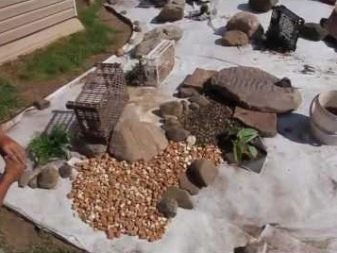
-
The previously removed soil layer is cleared of weeds, mixed with peat and humus, and then laid on top of the drainage system. In the process of laying the soil, you can make the device of small hills;
-
Stones can be laid only after all layers of drainage and soil have shrunk;
-
Large stone elements should be installed on smaller stones used as a base. This is done so that when watering the stone does not change its correct position;
-
After all the stones are installed, planting begins. For beginner decorators, it is best to first arrange the plants directly in plastic pots at the places of their planting in order to see the whole composition as a whole, and only after choosing the most optimal location, start planting them in the ground;
-
the plants are planted in the following sequence - at the very beginning, the largest and tallest specimens are planted, and then the smaller ones;
-
After planting the plants, they must be watered.


A mini flower garden can even be created from improvised materials - an old car tire, a barrel, a clay jug. The basic steps will be the same.
More complex designs using waterfalls or ponds are created a little differently. The preparation stage will need to be supplemented by the preparation of a pit for the basin of the reservoir. As a container, you can use special bowls that are sold ready-made or use an old basin or a bath that has served its life.
If there is nothing suitable, the pit is lined with a moisture-proof film in several layers, the ends of which are pressed with stones and covered with earth.
Care
If your alpine slide is equipped with a reservoir, it must be periodically cleaned and the water replaced. For the winter, the water is completely drained. When leaving, special preparations are sometimes used that prevent water bloom. However, organic matter that enters the reservoir should not accumulate there, creating an environment for the growth of bacteria.
It is much easier to clean a shallow body of water, this circumstance should be taken into account when deepening the pit even at the construction stage.

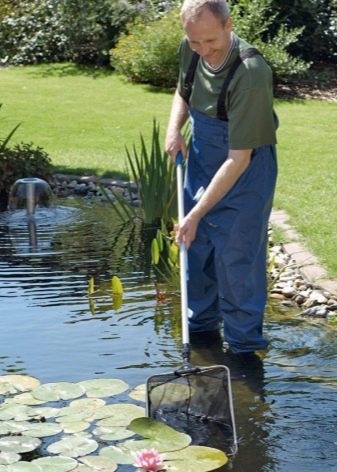
In order for the alpine slide to please with its beauty, it needs good care.
The main recommendations for care are as follows:
-
you can water the flower garden no more than once a day so that excess moisture does not rot the roots of the plants;
-
at least once a month, plants are fed with mineral fertilizers, while it is important that nutrients fall under the root system, and not flow down the slopes of the hill to the foot;
-
dead plant parts, as well as the leaves of other plants or trees brought by the wind, must be removed in a timely manner, since decomposing, they will create a breeding ground for molds, bacteria and pests;
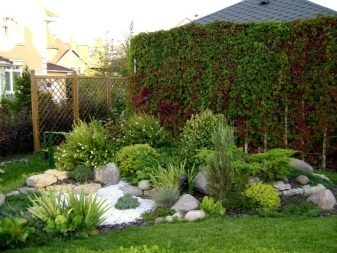

-
it is necessary to ensure that the larvae of harmful insects, aphids, slugs do not appear on the plants, when they appear, it is necessary to urgently take measures to destroy them;
-
do not allow the growth of weeds - weeding must be carried out weekly;
-
the location of the fine gravel must be corrected with a light garden rake, returning the pebbles to their main permanent place.


Before the arrival of the first frost, an alpine flower garden or rockery needs to be prepared for wintering.
To do this, you need to carry out the following types of work:
-
heat-loving plants are dug up and transferred to a closed ground or greenhouse;
-
annual plants are completely removed from the soil;
-
the remaining plants are covered with a special non-woven fiber cloth, which allows the plants to overwinter and prevents them from overheating;
-
it is necessary to protect the alpine slide from frost and strong winds, for which it is covered with special shields or a shelter made of willow twigs, spruce branches - only a slide well sprinkled with snow is not exposed to low temperatures and atmospheric influences;
-
water is drained from the reservoir, pumping electrical equipment (if any) is taken out and stored at home. In the event that it is impossible to drain the water, several rubber balls are placed in the reservoir, which will restrain the pressing force of the ice and will not allow it to break the container, which is the basis of the reservoir.


After the snow cover has melted, it is necessary to carry out preparatory work so that the flower garden meets the arrival of spring:
-
it is necessary to remove all dead plant parts;
-
check the placement and the reliability of the fixation of stones in the soil; if necessary, it is necessary to strengthen or return to their place the "escaped" stones;
-
mulch and a fresh layer of peat with humus are added to the soil, replenishing natural losses;
-
with the arrival of heat, the plants that were kept warm are planted and all the voids are again filled with fresh specimens.

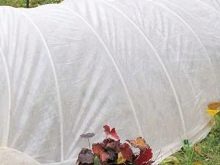

As you can see, it takes a lot of work and time to admire the alpine slide. But it's worth it - the construction of artificial landscapes creates coziness and an atmosphere conducive to relaxation.
Useful Tips
Experienced landscape designers often share tips for setting up a rockery or alpine flower garden with newbies.
There are some secrets of craftsmanship, taking into account which you can form a unique landscape on your site:
-
When creating an object, try to divide it into several zones, consisting of a hill, an inclined plane, imitation of talus, plateau, and various transitions. Thanks to this technique, the view of the entire structure will look new every time from a different angle of view, and the structure itself will not get bored, because you will want to consider and study it;
-
If you use material from tires as a base, try to decorate this base so that it is not noticeable - dig deep and cover with stones, use foam and dyes, wrap with geotextile and sprinkle with gravel;

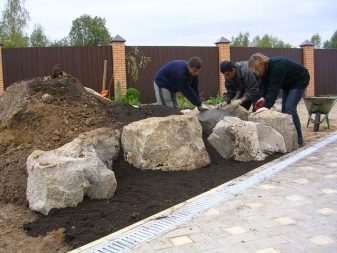
-
When planting flowers, take care that there is no excessive variegated picture, which quickly tires the eye. There may be several spots, but they look best scattered rather than a continuous variegated carpet;
-
Choose what will become the center of the composition - it may be a dwarf tree (which will be higher than other plants), an unusual texture, a large stone, a small waterfall or fountain, some special group of plants that attracts attention with shape or color;
-
You can decorate a flower garden with anything, but it is better to try to choose objects made of natural materials or their imitation - a wooden mill, an earthen jug, a marble statue;

-
Try to avoid artificial objects that are flashy in their colors - such "beauty" does not exist in nature, so they will look like alien elements in your flower garden;
-
Various garden lamps look good in the evening and at night. With a good location, the flower garden will look no worse than during the day.
When developing your own version of a flower garden, do not be afraid to experiment, because each such creation expresses the character and mood of the person who created it.


It is impossible to find two completely identical options - each will have something unique, its own, inimitable.
Beautiful examples
Here are the most interesting and easy-to-use flower beds that you can make yourself, and perhaps watching these examples can inspire you to do something of your own, unlike other options.
- This rock garden is made using large stones and gravel on a flat surface - the contrast of delicate colors and strict outlines of stones creates an impression of solidity and pristine beauty.
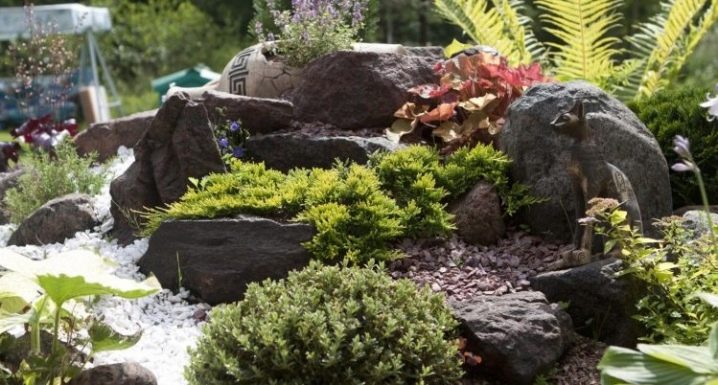
- This version of the alpine slide is complemented by a fountain, which plays a key role in this whole harmonious composition. The first glance is attracted to the water, but then you want to consider the surrounding flowers and stone ledges to the smallest detail.
- This is a rockery, it looks like an unusual flower bed. Attention here is taken by ampelous plants, which have a low height and completely cover the soil.


- The center of attention is this clay pot, which, like a cornucopia, pours streams of beautiful plants onto the flower garden. A skilful combination of colors and stones allows you to achieve a special unique beauty of the entire composition.
- In this version, the beauty of the stone is shown, and the plants with their fragility only emphasize its natural beauty and fundamentalness.


- The Alpine lawn is an example of how you can effectively and cost-effectively decorate your site, having done it all with your own hands and getting a lot of pleasure from the process itself and its result.

To create a living miracle with your own hands in an ordinary garden in collaboration with nature itself is the most real creative expression of oneself and the feeling of belonging to a certain magical sacrament. Try it yourself using various master classes and be sure of success!
For information on how to create your own rock garden, see this video.



































































The comment was sent successfully.